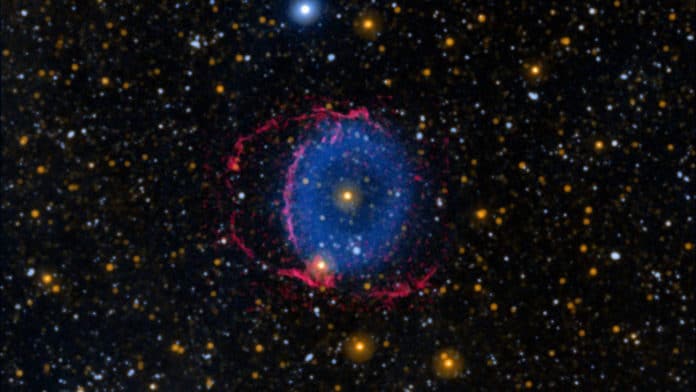In 2004, scientists with NASA’s Galaxy Evolution Explorer spotted an unusual object in our Milky Way Galaxy. The object appears a large, faint blob of gas with a star at its center.
In the ultraviolet wavelengths used by the satellite, the blob appeared blue. Here is the fact: Despite having a blue color, the blob doesn’t emit light.
Careful observations reveal that the blob has two thick blue-colored rings within it. Hence, astronomers dubbed it as Blue Ring Nebula.
For 16 years, the nebula is being studied using multiple Earth- and space-based telescopes, but the more they learned about it, the more mysterious it seemed.
A team of scientists, including Princeton University‘s Guðmundur Stefánsson, the Henry Norris Russell Postdoctoral Fellow in astrophysical sciences, combined ground-based observations with detailed theoretical modeling to investigate the object’s properties.
The nebula has two opposing fronts, suggesting a bipolar outflow of material from its star TYC 2597-735-1. The spectrum of TYC 2597-735-1 and its proximity to the Galactic plane suggests that it is an old star, yet it has abnormally low surface gravity and a detectable long-term luminosity decay, which is uncharacteristic for its evolutionary stage.
Its ring is made of hydrogen gas. The properties of this system suggest it is the remnant of two stars meeting their ultimate demise: an inward orbital dance that resulted in the two stars merging. The result offers a new window into the fate of many tightly orbiting binary star systems.
Stefánsson said, “We were in the middle of observing one night, with a new spectrograph that we had recently built when we received a message from our colleagues about a peculiar object composed of a nebulous gas expanding rapidly away from a central star. How did it form? What are the properties of the central star? We were immediately excited to help solve the mystery!”
Most stars in the Milky Way are in binary systems — pairs of stars orbiting one another. If they are close enough together, such systems can meet demise in a stellar merging event: As stars evolve, they extend. If they are close enough together, one of the stars can engulf its orbiting companion, causing the companion to spin inward until the two stars collide. As the companion loses its orbital energy, it can eject material away at high speeds.
Further evidence in support of this hypothesis came from observations with two different spectrographs on large telescopes on the ground: the HIRES optical spectrograph on the 10-meter Keck Telescope on top of Maunakea in Hawaii, and the near-infrared Habitable-zone Planet Finder on the 10-meter Hobby-Eberly Telescope at McDonald Observatory in Texas, a new near-infrared spectrograph that Stefánsson helped design, build and commission to detect planets around nearby stars.
Stefánsson said, “The spectroscopic observations were key in allowing us to understand the object further, from which we see that the central star is inflated, and we see signatures of accretion likely from a surrounding disk of debris.”
Keri Hoadley, a postdoctoral fellow at Caltech and lead author of the paper, said, “Indeed, the spectroscopic data coupled with theoretical modeling shows that the Blue Ring Nebula is consistent with the picture of a merging binary star system, suggesting that the inwards spiraling companion was likely a low-mass star.”
“The Blue Ring Nebula is the only object allowing an unobstructed view of the central stellar remnant, offering a clear window into its properties and yielding clues about the merging process.”
“The Blue Ring Nebula is rare. It is fascinating that we were able to find it, and we are excited about the possibility of finding more such objects in the future. If so, that would allow us to gain further insights into the remnants of stellar mergers and the processes that govern them.”
Journal Reference:
- Hoadley, K., Martin, D.C., Metzger, B.D. et al. A blue ring nebula from a stellar merger several thousand years ago. Nature 587, 387–391 (2020). DOI: 10.1038/s41586-020-2893-5
